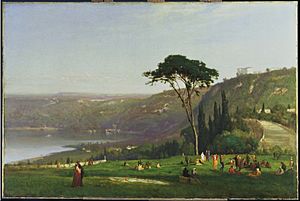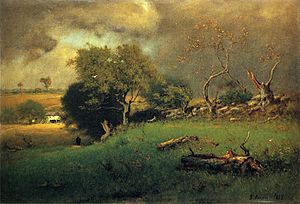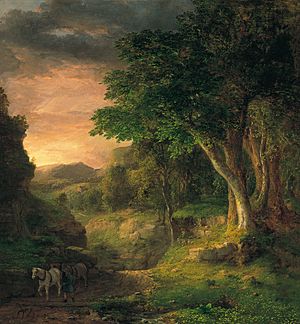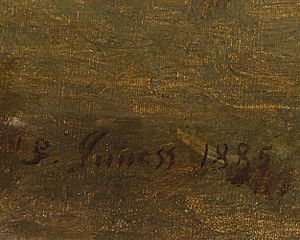George Inness facts for kids
Quick facts for kids
George Inness
|
|
|---|---|

George Inness, 1890
|
|
| Born | May 1, 1825 Newburgh, New York, U.S.
|
| Died | August 3, 1894 (aged 69) Bridge of Allan, Scotland
|
| Nationality | American |
| Education | Barbizon school of France |
| Known for | Landscape art, Painting |
| Movement | Hudson River School |
George Inness (born May 1, 1825 – died August 3, 1894) was a very important American landscape painter. He is known for his beautiful paintings of nature.
Many people today see Inness as one of the most important American artists of the 1800s. When he started painting, he was inspired by the Hudson River School artists. Later, he traveled to Europe. There, he studied famous old paintings and learned from artists of the Barbizon school. He also discovered the ideas of Emanuel Swedenborg, which were very important to him. These spiritual ideas showed up in his later paintings.
Inness painted for over 40 years and created more than 1,000 artworks. His style changed over time, but his paintings were always praised. People loved how he captured the mood, feeling, and atmosphere of a place. He wasn't just a realist (painting things exactly as they look) or an impressionist (focusing on light and color). Instead, Inness combined both styles. He wanted to show both the real world and a deeper, spiritual side in his art. He was a master of light, color, and shadow. His scenes often mixed blurry parts with sharp details. This helped him show how the physical world and spiritual feelings are connected. Inness said he tried to show the "reality of the unseen" in his art. He wanted to link "the visible upon the invisible."
During his lifetime, art critics called Inness one of America's greatest artists. He was often called "the father of American landscape painting." Inness is most famous for his later works. These paintings were part of the Tonalist art movement. They also showed his own unique American style.
Contents
George Inness: Early Life and Art Training
George Inness was born in Newburgh, New York. He was the fifth of 13 children. His father, John William Inness, was a farmer. His mother was Clarissa Baldwin.
When George was about five, his family moved to Newark, New Jersey. In 1839, he studied for a few months with a traveling painter named John Jesse Barker.
First Studio and Marriage
As a teenager, Inness worked in New York City. He was a map engraver for companies like Sherman & Smith and N. Currier. During this time, a French landscape painter, Régis François Gignoux, noticed his talent. Inness later studied with Gignoux. In the mid-1840s, he also took classes at the National Academy of Design. He studied the works of Hudson River School artists Thomas Cole and Asher Durand. Inness thought, "If these two can be combined, I will try." He showed his art at the National Academy for the first time in 1844.
Inness opened his first art studio in New York in 1848. In 1849, he married Delia Miller, but she sadly died a few months later. The next year, he married Elizabeth Abigail Hart. They had six children together.
Developing His Artistic Style
In 1851, a supporter named Ogden Haggerty helped Inness take his first trip to Europe. He went to paint and study. Inness spent 15 months in Rome, Italy. There, he studied landscapes by French artists Claude Lorrain and Nicolas Poussin. He rented a studio above the painter William Page. Page likely introduced Inness to Swedenborgianism, a spiritual belief system. Inness returned to America with his wife in May 1852. In 1853, he became an Associate member of the National Academy of Design. He became a full member in 1868.
Influence of the Barbizon School
During trips to Paris in the early 1850s, Inness was influenced by artists of the Barbizon school in France. Barbizon landscapes were known for their looser brushstrokes, darker colors, and focus on creating a mood. Inness quickly became the main American artist to use the Barbizon style. He made it his own unique way of painting. In 1854, during one of these trips, his son George Inness, Jr. was born in Paris. His son also became a famous landscape painter.
In the mid-1850s, the Delaware, Lackawanna and Western Railroad asked Inness to paint scenes of their growing railroad. The Lackawanna Valley, painted around 1855, shows the railroad's first roundhouse in Scranton, Pennsylvania. This painting combines technology and nature. Later, Inness would paint more natural scenes, often from memory in his studio. He became more interested in the artistic elements of his paintings.
Later Years and Spiritual Art

In 1860, Inness moved from New York City to Medfield, Massachusetts. He turned a barn into his art studio. From 1862 to 1863, he taught art to Charles Dormon Robinson. Robinson later became known for his paintings of California.
Inness moved to Eagleswood, New Jersey in 1864. He went back to Europe in the spring of 1870. He lived in Rome and visited places like Tivoli, Lake Albano, and Venice. In 1878, he returned to New York City and set up a studio. That same year, he showed his work at the Universal Exposition in Paris. Besides painting, he also wrote art reviews for newspapers.
His paintings from the 1860s and 1870s often showed wide, scenic views. They often had cloudy or stormy skies. These included views of America, like Autumn Oaks (1878) and Catskill Mountains (1870). He also painted scenes from his travels to Italy and France. These paintings showed his skill in composition, drawing, and using color to create emotion. They made Inness one of America's most successful landscape painters.
In 1877, Inness built a home and studio in Tarpon Springs, Florida. He chose to paint the pine woods there, which some found plain. His painting Early Morning – Tarpon Springs shows this environment.
Spiritual Influence on His Art
Over time, Inness's art showed the influence of Emanuel Swedenborg's ideas. Inness was especially interested in the idea that everything in nature has a spiritual meaning. He believed that God's spirit flows into nature, allowing it to exist. Another person who influenced Inness was William James, who also followed Swedenborg's ideas. Inness was inspired by James's idea that our thoughts flow like a stream. He also liked James's ideas about how spiritual experiences change how we see nature.
In 1884, a big show of Inness's art was held by the American Art Association. This brought him much praise in the United States. He became famous around the world when he won a gold medal at the 1889 Paris Exposition.
George Inness: Final Years and Legacy

After Inness moved to Montclair, New Jersey in 1885, his art became even more spiritual. Especially in the last ten years of his life, his paintings showed this mystical side. He used more abstract shapes, softer edges, and rich colors (like in October, 1886). He created dramatic contrasts between sky and earth (Early Autumn, Montclair, 1888). He also focused on close-up views of landscapes (Sunset in the Woods, 1891). His painting style became more personal and sometimes very bold. This bold style is what makes Inness different from other artists who painted with similar feelings, like the Luminists.
In an interview, Inness said that "The true use of art is, first, to cultivate the artist's own spiritual nature." Even though he cared deeply about spiritual and emotional ideas, Inness also studied color scientifically. He also used a mathematical approach to how he arranged his paintings. He believed that "Poetry is the vision of reality."
Inness died in 1894 in Bridge of Allan, Scotland. His son said that Inness was watching the sunset. He "threw up his hands into the air and exclaimed, 'My God! oh, how beautiful!'" Then he fell to the ground and died minutes later. A public funeral for Inness was held at the National Academy of Design. A special exhibition of his work was held in New York City.
He is buried in Rosedale Cemetery in Montclair, New Jersey, along with his son, George Inness, Jr.
Images for kids
Works
- A Bit of the Roman Aqueduct (1852)
- Spring Blossoms, Montclair, New Jersey (c. 1891)
See also
 In Spanish: George Inness para niños
In Spanish: George Inness para niños




























